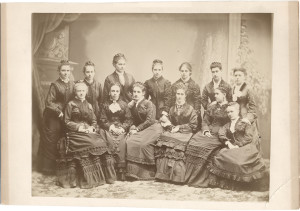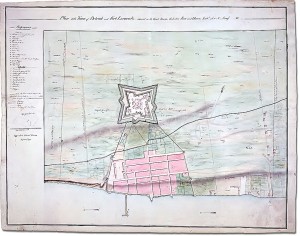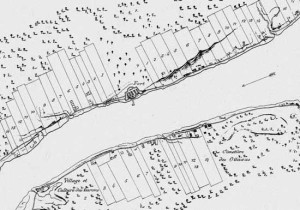The focus of the January 30th professional development day will delve deeper into the year-long investigation of historical perspective and the way we can use this narrative to tell the story of place in new and compelling ways. The History Affinity Group began this journey after the successful Summer Institute and Ypsilanti Native American tour, sparking discussion about how to use history as a starting point for exploring EcoJustice themes. In the October PD, Matt Siegfried followed up on the Summer Institute with an exploration of the historical perspective through place, using photos, buildings, streets, maps and historical markers as guideposts along the way.
To delve into this topic further, Experiencia Academy, the Waldorf School, John Paul II and Neinas Elementary have been working with Matt to understand how their individual school grounds and buildings are a part of the history of the Detroit area. For instance, on November 1st, teachers took a tour of a Huron Village site in Ypsilanti, exploring Native American landscape and history of the region, from the Pontiac’s Rebellion and Tecumseh in the War of 1812 to early Indian farming and village life, and post-European development. Following this, the Waldorf School took a tour of the Detroit River all the way to the Huron River, identifying different uses of the waterfront by different Native groups, European settlers and modern industry. In December, Experiencia students came to Eastern Michigan University and explored the placement and history of buildings and roads, and how they mirrored Native trails, French development and English settlement.
Following the professional development day, comment on how you can use place-based history as well as our new website and blog to engage your class in sharing the story of their place. There are so many ways this can happen effectively, whether it be a slideshow, interviews with community elders, or sharing resources that schools found helpful in learning their community’s history. Please reflect on one of the following inquiry questions in the blog comments below:
- Can you have PBE without a historical perspective?
- How can we use a historical perspective to connect ourselves and our students to our own place?
- Once we understand the historical perspective of a place, what is our ethical responsibility to that place?
- What entry point allows us to begin to investigate a historical perspective in our work?
Matt Siegfried has shared some photos and documents from his investigations with teachers. Use this blog as a place to reflect on your experience with your own history of place and what you’ve learned through the SEMIS PD!




I am still thinking about some questions that Matt raised for me on Friday. Very, very thought-provoking presentation Matt. Thank you! Some really interesting and potentially disturbing 🙂 questions that have come up for me are—If there is no non-violent golden age of humanity, what are humans capable of in terms of creating peaceful and healthy societies? What does a vision of our future look like that both acknowledges human capacity for violence, and creates a viable way of living together?
And then I think a core place-based question in our region and also a core EcoJustice question is—What did the living landscape (both human and non-human) look like throughout history in the Detroit area, especially before the early 1900’s. What parts of this living landscape do we want to re-vitalize in our present and future? What parts can’t we re-vitalize? How do we support living systems in a way that marries the possibilities of the past, present, and future? Maybe we can think together as a Coalition about these questions? I’m curious about what other folks took from Matt’s presentation. What questions are on your mind after Friday?
At Experiencia, we are working with Matt to learn the history of our land’s use, and look forward to participating in a bus tour of our area, including Southwest Detroit. Additionally, his idea of using themed bibliographies to spark research is going to factor into our upcoming Autobiography unit in ELA. They will be used in the ‘Where I come from’ chapter of this project, letting the students choose which layer of their neighborhood to learn about. Thanks, Matt!
Every time I come to SEMIs there is a new awakening or a new birth of ideas that take place. Today while listening to a wonderful presentation by Matt and seeing the historic images and maps of Neinas I had the idea to do a timeline for our schools 100th birthday in 2016. Having someone with as much knowledge and passion as Matt will be instrumental in assisting teachers in helping their children create the timeline is important. This partnership wouldn’t take place without SEMIs.
At DIT, we have been struggling with historic perspective and place. My students worked with the DIA last year on a historical perspective project and they wanted to use history within our community in our latest art project. My question is how to begin in relation to Matt’s presentation today?
Hi Chad,
I think you should start small. There’s no way to take in the history of Detroit, or even a neighborhood, in one big bite. Find an “entry point” around the school; an old building, a street, a person, an event, and begin exploring the specific place, adding context as you go. When several small projects like that develop over time, a picture emerges of the area.
As our school moves into its 100 year, we really started to think about our history. It’s an exciting time! We want to give our students a sense of place. THEIR place. Whether its their place within a timeline, within their community, they need to know they have a voice. As teachers, we are charged with helping them find their voice and to do the important work ahead. Still processing the questions above.